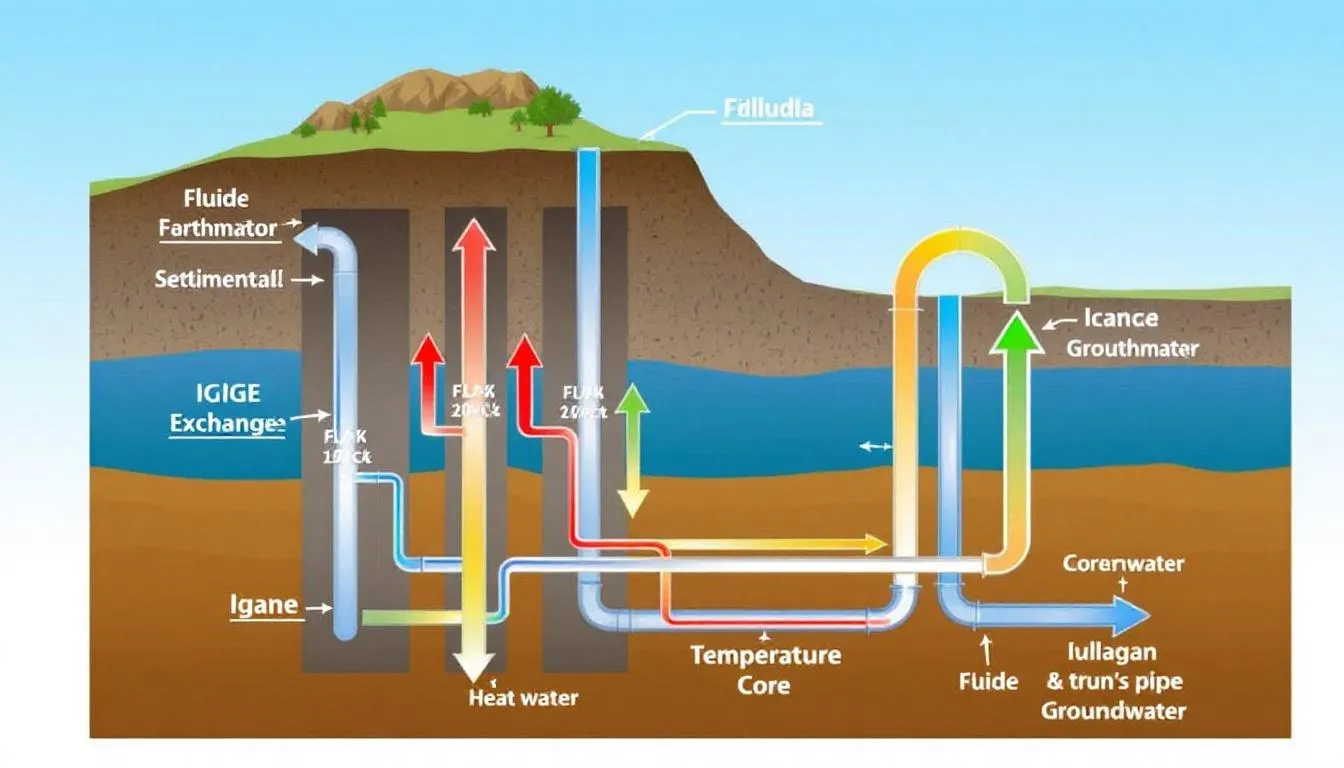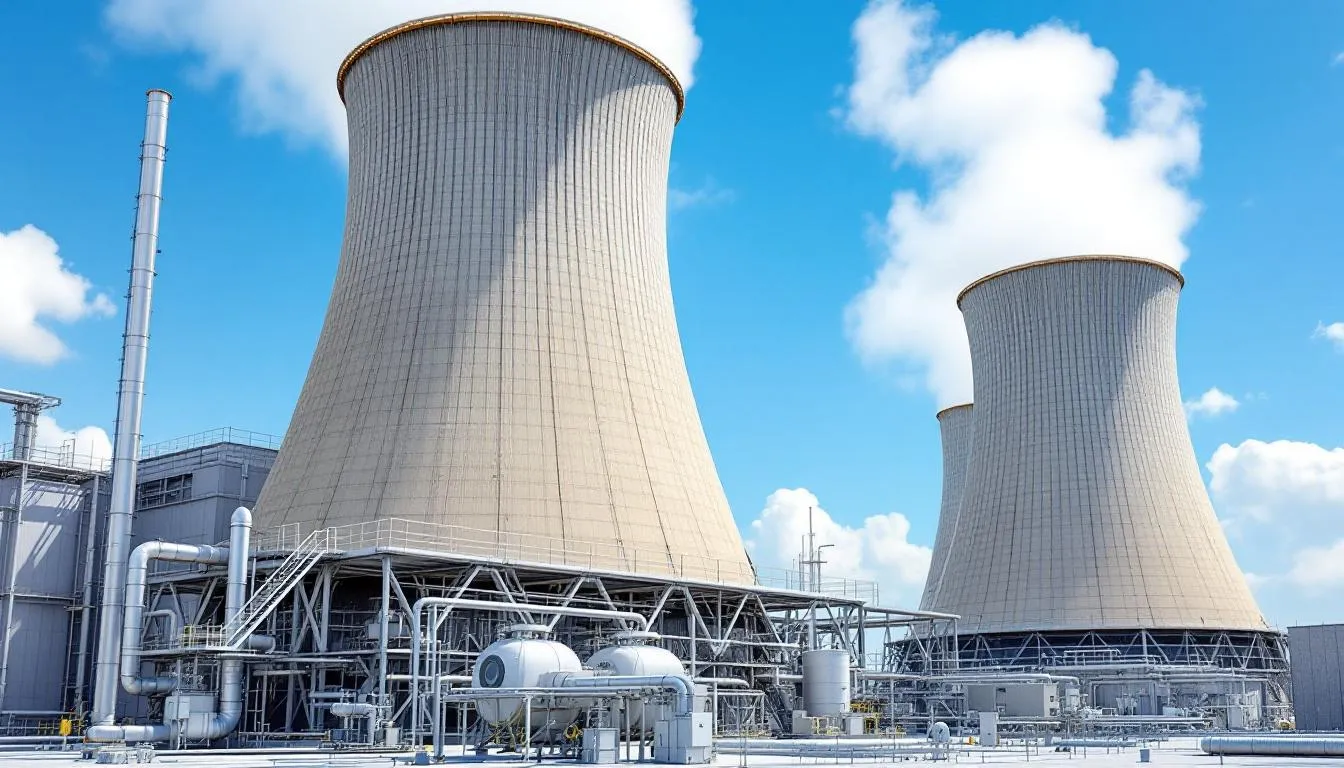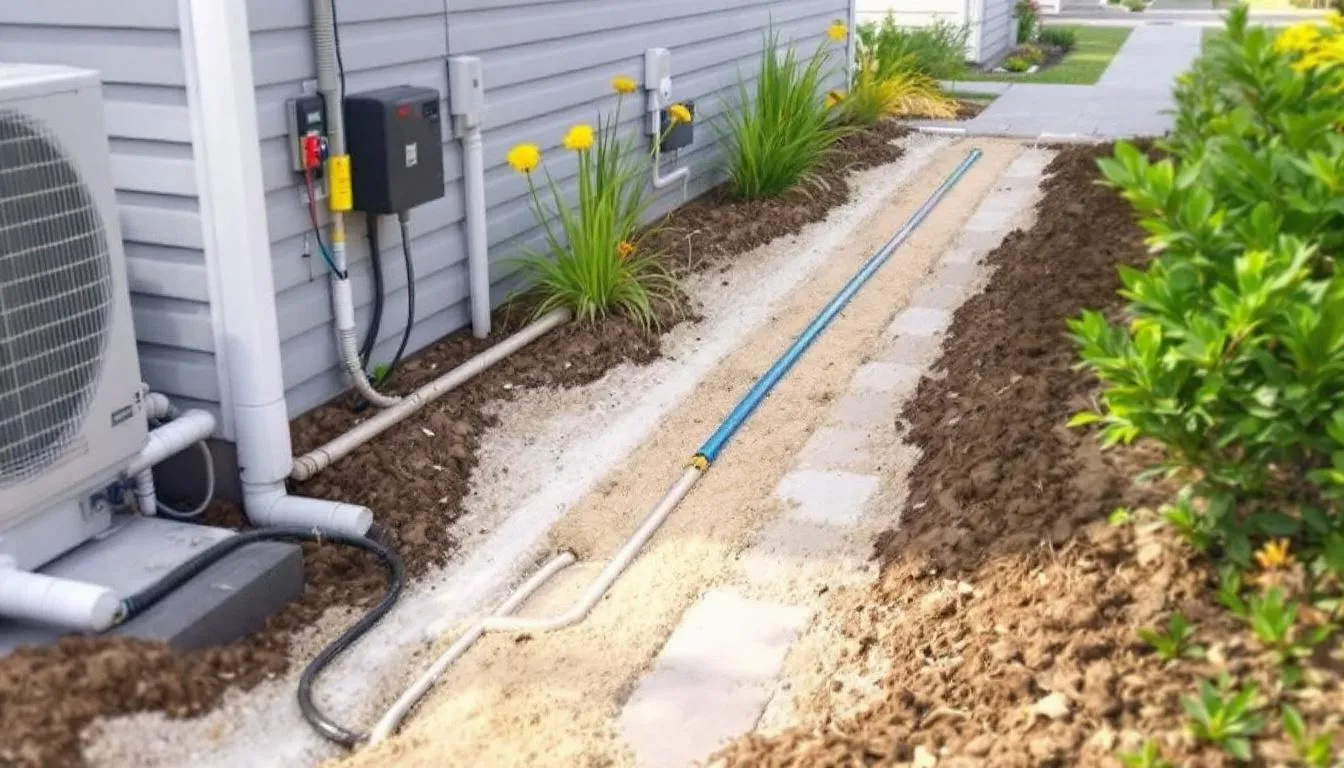Geothermal Energy: Harnessing Earth’s Natural Heat for Power and Climate Control
Key Takeaways
Geothermal energy harnesses heat from Earth’s interior through underground reservoirs of hot water and steam at temperatures ranging from 225°F to over 360°F
Three main applications include electricity generation through power plants, direct heating for buildings and industrial processes, and ground-source heat pumps for efficient heating and cooling
The U.S. leads global geothermal electricity capacity with potential to reach 90 GW by 2050, while geothermal heat pumps could serve 36 million American homes
Enhanced geothermal systems expand potential by creating artificial reservoirs in hot dry rock, though they may cause minor seismic activity
Geothermal energy provides 24/7 renewable power with minimal emissions but requires high upfront investment costs of $2-7 million per megawatt
Get a quote for converting to geothermal energy
Deep beneath our feet lies a virtually unlimited source of clean energy that has powered Earth for billions of years. Geothermal energy represents one of the most reliable renewable energy sources available today, offering continuous power generation and efficient climate control solutions that don’t depend on weather conditions or fossil fuel imports.
Unlike solar panels that need sunlight or wind turbines that require consistent breezes, geothermal systems tap into the planet’s constant internal heat to generate electricity, heat buildings, and provide cooling year-round. From massive power plants producing hundreds of megawatts to residential heat pumps serving individual homes, this technology is transforming how we think about sustainable energy.
The image depicts an underground geothermal reservoir in a volcanic landscape, featuring visible steam vents and bubbling hot springs, which are key components of geothermal energy systems. This natural setting illustrates the potential of geothermal resources for renewable energy generation through the harnessing of heat from the Earth's interior.
What is Geothermal Energy
Geothermal energy is thermal energy extracted from Earth’s crust, originating from the planet’s formation billions of years ago and ongoing radioactive decay of elements like uranium and thorium deep within earth’s interior. This continuous process maintains earth’s core at temperatures similar to the sun’s surface, creating a natural geothermal gradient of approximately 25°C per kilometer depth below earth’s surface.
Underground reservoirs containing hot water, steam, and heated rock formations exist at various temperatures and depths throughout the planet. These geothermal resources form when groundwater seeps down through earth’s crust and gets heated by contact with hot rocks or magma chambers. The heated water then rises toward earth’s surface through natural fractures or human-made wells.
Accessing these geothermal sources requires wells drilled from just a few feet for ground-source heat pumps to several miles deep for high-temperature electricity generation. The depth needed depends on the intended application and local geological conditions, with some geothermal reservoirs located close to earth’s surface while others require extensive drilling through solid rock formations.
The temperatures available range dramatically based on depth and location. Shallow geothermal systems operate at stable ground temperatures of 50-60°F year-round, while deep geothermal reservoirs can exceed 600°F in volcanically active regions. This wide temperature range enables diverse applications from space heating to industrial processes requiring very hot water.
This cross-section view of a geothermal well system illustrates the underground pipes and the heat exchange process, showcasing how geothermal energy is harnessed from the earth's interior. The image highlights the flow of geothermal fluids through underground reservoirs, emphasizing the renewable energy potential of geothermal power plants for electricity generation.
Types of Geothermal Power Plants
Dry Steam Power Plants
Dry steam power plants use underground steam piped directly to turbines without any water conversion process, representing the simplest and oldest form of geothermal electricity generation. These facilities tap steam that reaches temperatures greater than 455°F and pipe it directly from underground reservoirs to drive turbines for electricity production.
The Geysers in California stands as the only operational dry steam facility in the United States and one of just two known dry steam resources in the country. This geothermal plant has operated for over 60 years, demonstrating the long-term reliability of geothermal power generation when proper reservoir management techniques are applied.
Limited to only two known dry steam resources in the U.S., these plants nonetheless achieve highly efficient electricity generation with minimal environmental impact. The direct use of steam eliminates the need for secondary working fluids and reduces system complexity compared to other geothermal power plant designs.
Flash Steam Power Plants
Flash steam power plants utilize high-temperature water above 360°F (182°C) from geothermal reservoirs under high pressure conditions. When this pressurized hot water reaches the surface, pressure reduction causes rapid water vaporization into steam for turbine operation and electricity generation.
The flash steam process occurs when very hot water under pressure experiences a sudden pressure drop, causing a portion of the water to “flash” into steam. This steam drives turbines connected to generators, while the remaining liquid water gets reinjected back into the geothermal reservoir to maintain system sustainability.
Water reinjection systems maintain reservoir pressure and extend plant lifespan by returning cooled water to underground formations. This closed-loop approach prevents resource depletion and ensures the geothermal reservoir remains productive for decades of continuous operation.
Flash steam power plants represent the most common geothermal power plant type globally, especially in countries like Iceland and the Philippines where high-temperature geothermal resources are abundant. These facilities can operate efficiently for 30-50 years with proper maintenance and reservoir management practices.
Binary Cycle Power Plants
Binary cycle power plants access lower temperature geothermal resources from 225-360°F using secondary working fluids instead of direct steam. These plants use organic compounds with much lower boiling points that get vaporized by geothermal heat to drive turbines for electricity generation.
The organic compound, often an organic fluid like isobutane, has a low boiling point that allows it to vaporize at relatively low temperatures compared to water. This secondary fluid circulates through a closed system where it absorbs heat from geothermal water, vaporizes to drive turbines, then condenses back to liquid form for reuse.
Binary plants operate as closed-loop systems preventing geothermal fluid contact with working fluid for minimal emissions and environmental impact. The geothermal water never comes into direct contact with the turbine system, reducing corrosion and eliminating toxic elements that might be present in geothermal fluids.
Enhanced capability to utilize low-temperature resources and coproduced water from oil and gas wells expands the geographic potential for geothermal electricity generation. Binary cycle technology makes electricity generation possible in areas where geothermal temperatures are too low for flash steam plants, significantly expanding development opportunities.
The image depicts a modern binary cycle geothermal power plant, featuring large cooling towers and advanced generating equipment designed to harness geothermal energy. This facility utilizes geothermal resources to generate electricity, contributing to renewable energy sources and reducing reliance on fossil fuels.
Geothermal Heating and Cooling Systems
Ground-source heat pumps utilize stable underground temperatures just 2 meters below earth’s surface for residential and commercial buildings. These geothermal heat pump systems take advantage of the fact that ground temperatures remain relatively constant year-round, typically between 50-60°F, regardless of air temperature fluctuations above ground.
District heating systems serve multiple buildings or entire communities through centralized geothermal distribution networks. These systems distribute hot water from geothermal sources through insulated pipes to heat buildings across large areas, eliminating the need for individual heating systems and reducing overall energy consumption.
Direct use applications include space heating, greenhouse operations, fish farming, and industrial process heating using geothermal heat without electricity generation. Many industrial processes require temperatures achievable through direct geothermal heating, while greenhouses can melt snow and maintain optimal growing conditions year-round using geothermal heat.
Heat pump technology leverages ground as a heat source in winter and heat sink in summer for year-round climate control. During winter, the heat pumps extract thermal energy from the relatively warm ground and concentrate it for building heating. In summer, the process reverses to remove heat from buildings and reject it to the cooler ground.
Coefficient of performance typically reaches 3-5 times higher efficiency than conventional heating and cooling systems. This means geothermal heat pumps deliver 3-5 units of heating or cooling energy for every unit of electricity consumed, making them among the most energy-efficient HVAC technologies available.
The image depicts a residential geothermal heat pump installation featuring a ground loop system, which utilizes geothermal energy from the earth's surface to provide efficient heating and cooling for homes. This renewable energy system harnesses the natural heat stored in the ground, reducing reliance on fossil fuels and promoting sustainable energy use.
Enhanced Geothermal Systems
Enhanced geothermal systems create artificial reservoirs through high-pressure water injection into hot dry rock formations where natural water circulation is limited. This enhanced geothermal technology expands potential development areas beyond naturally occurring hydrothermal resources by engineering the necessary permeability for fluid circulation.
Hydraulic fracturing techniques expand natural permeability in geothermal resources by creating networks of fractures in hot rocks. Water injection under high pressure opens existing fractures and creates new pathways for fluid circulation, establishing the artificial reservoir needed for heat extraction.
Enhanced geothermal system development provides access to geothermal potential in areas lacking natural hydrothermal activity, dramatically expanding the geographic scope for geothermal energy development. This technology makes geothermal development possible in regions with adequate subsurface heat but insufficient natural water circulation.
U.S. Geological Survey estimates of 500,000 megawatts potential in western United States demonstrate the massive scale of enhanced geothermal opportunities. This potential represents hundreds of times the current installed geothermal capacity and could meet a significant portion of national electricity demand.
Associated seismic risks include induced earthquakes, as experienced in Basel, Switzerland where an enhanced geothermal project was cancelled due to earthquake concerns. While most induced seismic activity is minor, proper monitoring and risk assessment are essential for enhanced geothermal development in populated areas.
Benefits of Geothermal Energy
Continuous 24/7 electricity generation independent of weather conditions provides baseload power with capacity factors exceeding 90%. Unlike wind energy or solar power that fluctuate with weather conditions, geothermal power plants operate consistently regardless of external factors, making them valuable for grid stability.
Domestic energy security reduces dependence on imported fuels and price volatility associated with fossil fuel markets. Geothermal energy provides a stable, locally-controlled energy source that shields consumers from international energy price fluctuations and supply chain disruptions.
Employment generation of approximately 34 jobs per megawatt exceeds job creation from wind and solar projects. The geothermal industry creates both construction jobs during development and permanent operational positions, contributing to local economic development in rural areas where many geothermal resources are located.
Minimal land footprint compared to coal, nuclear, and wind energy facilities allows geothermal development with less environmental disruption. A typical geothermal plant requires only 1-8 acres per megawatt of installed capacity, significantly less than coal power plants or wind farms.
Lower lifecycle greenhouse gas emissions than solar PV and natural gas power generation establish geothermal as one of the cleanest electricity sources available. Geothermal plants emit only small amounts of carbon dioxide, hydrogen sulfide, and other gases that are naturally present in geothermal fluids.
Baseload power capability supports grid stability and renewable energy integration by providing consistent electricity output. Grid operators value geothermal’s reliability for meeting minimum electricity demand and balancing intermittent renewable sources like wind and solar.
Environmental Impact and Sustainability
Low greenhouse gas emissions occur through release of CO2, hydrogen sulfide, methane, and ammonia at levels significantly below fossil fuel power plants. Modern geothermal facilities capture and reinject most gases, minimizing atmospheric emissions while maintaining operational efficiency.
Water conservation through reinjection systems and minimal freshwater consumption distinguishes geothermal from conventional power plants that require large volumes of cooling water. Geothermal plants typically consume 1-3 gallons per megawatt hour compared to 400-720 gallons for fossil fuel plants.
Potential for land subsidence, surface uplift, and induced seismicity requires monitoring and management throughout geothermal project lifecycles. Proper reservoir management through balanced injection and extraction prevents most subsidence issues while monitoring systems detect any ground movement.
Toxic elements including mercury and arsenic may be present in geothermal fluids, requiring mitigation through proper fluid handling and treatment systems. Modern geothermal plants employ closed-loop systems and treatment technologies to prevent release of potentially harmful substances.
Long-term sustainability requires balanced extraction and reinjection to maintain reservoir temperatures and pressure over decades of operation. Successful geothermal projects demonstrate that properly managed reservoirs can produce energy for 50+ years without significant decline in output.
The image depicts a geothermal district heating system in an urban environment, showcasing multiple buildings connected to a network that utilizes geothermal energy for space heating. This renewable energy system taps into underground reservoirs to provide efficient thermal energy, reducing reliance on fossil fuels.
Challenges and Disadvantages
High capital costs ranging from $2-7 million per megawatt capacity for power plant development represent the primary barrier to geothermal expansion. These upfront costs include exploration, drilling, plant construction, and transmission infrastructure, making project financing challenging despite low operating costs.
Geographic limitations restrict development to areas with accessible geothermal resources, typically near tectonic plate boundaries or volcanic regions. While enhanced geothermal systems expand development potential, the highest quality geothermal resources remain concentrated in specific geological formations.
Resource depletion risks from over-extraction require careful reservoir management to prevent temperature and pressure decline. Some geothermal fields have experienced reduced output when extraction rates exceeded the reservoir’s natural recharge capacity, emphasizing the need for sustainable production practices.
Potential for precipitate scaling reduces flow rates and causes maintenance downtime as minerals dissolved in geothermal fluids crystallize in pipes and equipment. Regular maintenance and chemical treatment help manage scaling issues, but they add to operational costs and complexity.
Technical challenges in enhanced geothermal systems include drilling costs and induced seismicity risks that may limit development in populated areas. Deep drilling for enhanced geothermal projects can cost millions of dollars per well, while hydraulic fracturing may trigger earthquakes.
Global Geothermal Development
United States leadership in installed geothermal capacity includes major developments in California, Nevada, and Oregon where favorable geology supports large-scale electricity generation. The U.S. has over 3.7 gigawatts of installed capacity, representing about 25% of global geothermal electricity production.
Rapid growth in Indonesia, Philippines, Turkey, and Kenya demonstrates expanding global geothermal markets in regions along the Pacific Ring of Fire and other tectonically active areas. These countries are developing substantial geothermal resources to meet growing electricity demand while reducing fossil fuel dependence.
The 2019 GeoVision analysis projected 60 GW U.S. capacity and 17,000 district heating systems by 2050, representing a dramatic expansion from current levels. This growth scenario assumes continued cost reductions and supportive policies for renewable energy development.
Enhanced Geothermal Shot™ 2022 analysis increased potential to 90 GW with cost reduction targets that would make enhanced geothermal systems competitive with other electricity sources. This initiative aims to reduce enhanced geothermal costs by 90% by 2035 through technological advances.
Next-Generation Geothermal Power reports suggest up to 300 GW may be possible with advanced storage and technologies that could revolutionize the industry. Integration with energy storage and hybrid renewable systems could multiply geothermal’s contribution to clean electricity generation.
International development along tectonic plates boundaries includes promising projects in the Pacific Ring of Fire and East African Rift Valley where natural geothermal activity creates ideal conditions for development. Countries like Kenya and Ethiopia are rapidly expanding geothermal capacity to meet energy needs.
The image depicts a global map highlighting major geothermal development regions and the installed capacity of geothermal power plants by country, illustrating the potential of geothermal energy as a renewable energy source for electricity generation. Different colors and shading indicate varying levels of geothermal resources and capacity across various countries, showcasing the distribution of geothermal systems around the world.
FAQ
How deep do geothermal systems need to be drilled? Geothermal heat pumps operate at depths of just 2 meters below earth’s surface where ground temperatures remain stable year-round. However, geothermal power plants may require wells drilled several miles deep to access high-temperature reservoirs above 225°F needed for electricity generation. Enhanced geothermal systems often drill even deeper to reach temperatures greater than 400°F in hot dry rock formations.
Can geothermal energy cause earthquakes? Enhanced geothermal systems can trigger minor induced seismicity through hydraulic fracturing used to create artificial reservoirs in hot rocks. Most conventional geothermal plants are located away from population centers where earthquake risks are generally manageable through proper monitoring. The Basel, Switzerland enhanced geothermal project was cancelled due to earthquake concerns, highlighting the importance of seismic risk assessment.
What is the lifespan of a geothermal power plant? Geothermal power plants typically operate for 30-50 years with proper maintenance and reservoir management, though some facilities like The Geysers have operated for over 60 years. The underground infrastructure including wells and reservoirs can last even longer when managed sustainably through balanced extraction and reinjection practices.
How does geothermal energy compare to solar and wind power? Unlike solar and wind energy that fluctuate with weather conditions, geothermal provides continuous baseload power 24/7 regardless of external factors. However, geothermal development is geographically limited to areas with accessible geothermal resources, while solar and wind can be deployed more widely. Geothermal typically has higher upfront costs but lower operating expenses over its longer lifespan.
What are coproduced geothermal resources? Coproduced resources are hot water extracted alongside oil and natural gas from existing oil and gas wells, offering potential for electricity generation using binary cycle technology without additional drilling costs. This approach can utilize the thermal energy in water that would otherwise be disposed of, creating additional revenue streams for oil and gas operations while reducing waste.






